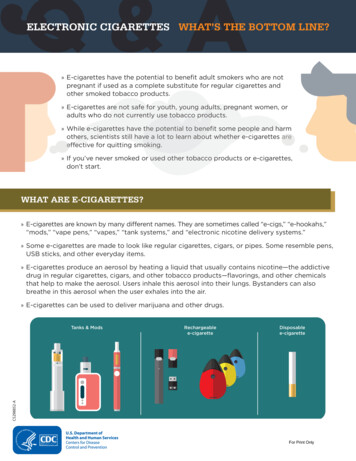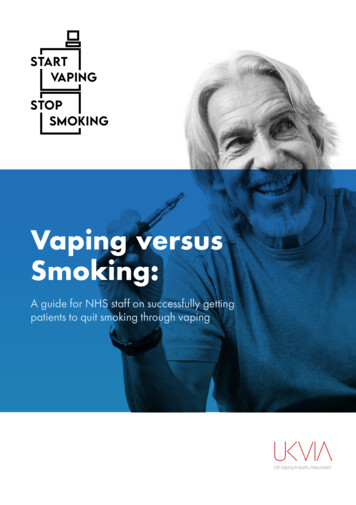
Transcription
Sapru et al. BMC Public Health(2020) EVIEWOpen AccessE-cigarettes use in the United States:reasons for use, perceptions, and effects onhealthSakshi Sapru1, Mridula Vardhan1, Qianhao Li1, Yuqi Guo1, Xin Li1,2† and Deepak Saxena1,3*†AbstractBackground: Many researchers claim electronic cigarettes (e-cigarettes) to be a breakthrough invention for tobaccousers that aspires to curb their addiction to conventional cigarettes. Claimed to be safer by their promoters, thesesmokeless devices have become increasingly popular since their arrival on the market among users of all ages,especially adolescents. This paper investigated the trends in e-cigarette usage since the time it arrived in the UnitedStates, highlighting the highest surge that has occurred in adolescent e-cigarette use. It also aimed to understandthe reasons and perceptions behind the ever-increasing use of e-cigarettes by adolescents.Main body: With the advent of e-cigarettes and common positive perceptions regarding their use, we are at risk ofreversing the years of efforts regarding tobacco control and instead advance towards a new addiction withcurrently unknown long-term health hazards. There is substantial data showing a significant increase of e-cigaretteusers in the United States, especially among adolescents. The aim of this review was to explore the reasons behindthis widespread increase in the use of e-cigarettes among the teenage population in the US and also to uncoverthe common perceptions about these new electronic delivery systems. In addition, this review attempted tosummarize health benefits and hazards associated with e-cigarette use as it crucial to have the right informationamong its users regarding the health effects of e-cigarette use.(Continued on next page)* Correspondence: ds100@nyu.edu†Xin Li and Deepak Saxena contributed equally to this work.1Department of Molecular Pathobiology, New York University College ofDentistry, 345 E 24th St, Room 921B, New York, NY 10010, USA3Departments of Surgery, New York University School of Medicine, New York,NY 10016, USAFull list of author information is available at the end of the article The Author(s). 2020 Open Access This article is licensed under a Creative Commons Attribution 4.0 International License,which permits use, sharing, adaptation, distribution and reproduction in any medium or format, as long as you giveappropriate credit to the original author(s) and the source, provide a link to the Creative Commons licence, and indicate ifchanges were made. The images or other third party material in this article are included in the article's Creative Commonslicence, unless indicated otherwise in a credit line to the material. If material is not included in the article's Creative Commonslicence and your intended use is not permitted by statutory regulation or exceeds the permitted use, you will need to obtainpermission directly from the copyright holder. To view a copy of this licence, visit http://creativecommons.org/licenses/by/4.0/.The Creative Commons Public Domain Dedication waiver ) applies to thedata made available in this article, unless otherwise stated in a credit line to the data.
Sapru et al. BMC Public Health(2020) 20:1518Page 2 of 10(Continued from previous page)Conclusion: E-cigarettes are more appealing than c-cigarettes for a variety of reasons, including cost, choice ofdifferent flavors, ease of accessibility, and use and impact of social media. There are also different perceptionsamong e-cigarette users, including both adolescents and adults. The former group may use them because of thesense of fashion associated with this novel device, and the latter might intend to quit conventional/combustiblecigarettes (c-cigarettes) by switching to e-cigarettes. However, it is important to note that e-cigarettes are a recentphenomenon; therefore, there is a lack of many long-term studies that can identify future health risks associatedwith e-cigarette use. We need more detailed studies that focus on the long-term health effects of e-cigarette use.Moreover, with the ever-increasing usage of e-cigarettes by adolescents (10 and 19 years), it is very important thate-cigarettes be incorporated into the current tobacco-free laws and ordinances. We conclude by stating that ecigarettes need stronger regulations to prevent youth access and use.Keywords: E-cigarettes, Nicotine, Aerosol, Vaping, Flavoring agents, Smoking, Oral heath, Cardiovascular healthBackgroundThe overall trend in e-cigarette smoking among adolescents(middle school [10–14 years] and high school [14–18 years])students is higher than in the adult population. The numberof current adolescent e-cigarette users has experienced an upward trend since e-cigarettes first arrived in the United States[1–3]. According to a US Health and Human Services reportin 2017, a nonlinear increase for current use of e-cigarettesamong high school students from 1.5 to 11.3% between 2011and 2017 occurred. In the case of middle school students, thecurrent use of e-cigarettes exhibited an upward progressionfrom 0.6 to 4.3% between 2011 and 2017 [4]. The 2018National Youth Tobacco Survey (NYTS) report stated that3.6 million adolescents in the US were currently using ecigarettes, and e-cigarette use has drastically increased, especially in the last few years (2017 to 2018) [5].Figure 1 illustrates the time line of e-cigarette introduction in USA and Fig. 2 depicts the “alarming increase” inthe number of middle and high school e-cigarette usersfrom 2017 to 2018. In the year 2018, CNN called ecigarettes a “Teen Epidemic” in a news bulletin. The problem of adolescent e-cigarette use has become a great concern, and it is therefore important to investigate theadoption of electronic substitutes by teens [3]. This articleinvestigated perceptions of e-cigarettes and further probesthe reasons why e-cigarettes have become popular amongusers, especially adolescents.Fig. 1 Timeline of electronic cigarettes (e-cigarettes)A brief History of E-cigarettesA Chinese pharmacist named Hon Lik, in associationwith the company Dragon Holding, invented ecigarettes, which they called Ruyan, meaning “smokelike”. The death of his father, who was a heavy smokerand died of lung cancer, motivated him to develop a lessharmful alternative to c-cigarettes. E-cigarettes cameonto the market in 2003 and were patented internationally in the year 2007. E-cigarettes entered the US marketin the same year and since then, have gained popularityamong both cigarette smokers and non-smokers (Fig. 1).Data concerning e-cigarette smoking trends over theyears in adults and young adultsAdult population ( 25 years)Among US adults, the number of e-cigarettes users increased from 1.8% in 2009 to 3.4% in 2010 [6]. The useof these products continued to increase in 2011 with5.8% of U.S. adults reporting the use of e-cigarettes inthat year [6]. Data from National Center for Health Statistics (NCHS) in 2015 showed that 3.7% of the U.S.adult population were current e-cigarette smokers. According to National Health Interview Survey of theUnited States in 2017, approximately 2.8% of the U.S.adult population were current e-cigarette smokers. According to Reuters Health, one in every 20 US adults hastried e-cigarettes. At present, approximately 10.8 million
Sapru et al. BMC Public Health(2020) 20:1518Page 3 of 10Fig. 2 Trend of e-cigarette usage among United States adolescents in the year 2017–2018American adults use e-cigarettes [7]. Therefore, it is interesting to note that the number of current adult ecigarette smokers showed an upward trend from 2010until 2014 [8] followed by a decline in 2017 [9].Young adult population (18–25 years)According to the National Health Survey, the percentage ofyoung adults who use e-cigarettes daily or some days increased from 2.4% in 2012 to 2013 to 5.2% in 2015. Inaddition, 40% of young adults who use e-cigarettes daily orsome days were never smokers before trying e-cigarettes. Incomparison with adults aged 25 years and older, youngadults (18–25 years) are more likely to try e-cigarettes andreport having used e-cigarettes in the past 30 days. Hence,we can see an increase in the number of e-cigarette usersover the years among young adults aged 18 to 24 years.Description of e-cigarettes and how they vary from c-cigarettesResearch has provided substantial evidence that controlof nicotine addiction is beneficial for the health ofsmokers regardless of age. Over the years, tobacco control programs and interventions have demonstratedmuch success in decreasing initiation in non-smokersand cessation in smokers. However e-cigarettes many reverse this success in smoking cessation.E-cigarettes are popular battery-operated devices used asan alternative for c-cigarettes. E-cigarette devices produceaerosol (gaseous mist) from a nicotine-containing liquid (eliquid) and a heating element. The user then inhales theaerosol through the mouth and lungs from which it isabsorbed into the bloodstream, and the remaining aerosolis exhaled. Many common terms are used for this deviceother than e-cigarettes, such as Juul (resembles a USB flashdrive), e-vaporizer, vapes, electronic nicotine delivery systems (ENDS), and e-hookahs. E-cigarettes come in differentshapes, including pen and regular cigarette shapes,portable pocket device, pen vaporizer, and box mod.There are two main types of e-cigarettes: (1) disposableand (2) cartridge models. The disposable type is an inexpensive alternative for beginners. On the other hand,the cartridge models are rechargeable and contain cartridges that can be refilled or exchanged.E-cigarettes differ from c-cigarettes in their basic design,nature of the smoke, and the way the vapor is produced.The basic components of e-cigarettes include an aerosolgenerator, a flow sensor, a battery, and a nicotinecontaining solution storage area. The effectiveness of ecigarettes as a nicotine delivery system can be controlledwith interchangeable parts, enabling users to modify thecharacter of the delivered aerosol by changing the voltage[10]. E-cigarettes produce a gaseous substance/mist at atemperature that is lower than its point of combustion byheating the liquid in the cartridge, which consists of nicotine, propylene glycol, glycerol, or a mixture of water, flavor, and other toxic substances. Research has indicated thepresence of trace levels of toxic compounds, namely,tobacco-specific nitrosamines (TSNAs), carbonyl compounds [11], and polycyclic aromatic hydrocarbons (PAHs)[12] in the e-liquids or aerosols of some commercially available products although most were found at much lowerlevels than in c-cigarette smoke. On the other hand, ccigarettes produce smoke by burning tobacco with fire.This smoke consists of recognized carcinogens, such as thecarbonyl compound, formaldehyde, organic compounds,
Sapru et al. BMC Public Health(2020) 20:1518such as benzene, tobacco-specific nitrosamines, free radicals, toxic gases, and heavy metals. There are more than7000 chemicals present in c-cigarette smoke, among which70 have been recognized as carcinogens [13, 14].What makes e-cigarettes more popular than c-cigarettes?Reasons for choosing and perceptions of e-cigarettesamong adolescent and adult usersAccording to research, various reasons have been reportedby regular e-cigarette users and occasional users for whye-cigarettes might be more appealing than regular combustible cigarettes. Curiosity, smoking cessation, healthbenefits, and use by a friend or family member were a fewcommon reasons apart from others, such as cost, easyavailability, and convenience of use for starting e-cigaretteuse. According to one study [15], in which the reasons(self-reported) for trying e-cigarettes by adolescents werelisted, curiosity was the top reason followed by good flavors, use by their friends and family, and finally low cost.In the study, some users claimed to have tried e-cigarettesbecause they thought that they were healthier than regularcigarettes, but only 5.9% tried to use them as a means toquit regular smoking. In another study [16] that exploredthe reasons for e-cigarette smoking by adults, the mostoften reported reason was smoking cessation followed bythe health benefits of e-cigarettes over c-cigarettes. However, the study highlights that the appeal of e-cigarettesextended beyond smoking cessation. Some other reasonsare described subsequently.Cost effectiveThe average cost of a pack of c-cigarettes in the US in2015 was 7.26; thus, the average cost of smoking ccigarettes at a rate of one pack a day for one year equaled 2650 [17]. On the other hand, the average cost of smoking e-cigarettes (cartridge models) at the same rate wasapproximately 1000. Moreover, e-liquid is even cheaperto use with an average cost of 511 per year. Therefore, ecigarettes are much more cost effective than c-cigarettes.Multiple flavorsE-cigarettes come in more than one hundred flavors,which make them very attractive, especially for theyounger generation. The availability of flavors such ascandy-floss, cinnamon, chocolate, vanilla, bubble gum,and mint makes them desirable to everyone. Accordingto research [18], these various flavor choices make ecigarettes more appealing to adolescents over thetobacco-flavored c-cigarettes. Moreover, different flavorslead to smoking initiation [19] and smoking progressionby masking the harsh taste of tobacco products, which isparticularly appeal to young users [20]. Candy-, fruitand menthol-flavored e-cigarettes appeal to adolescentsmore as compared to tobacco-flavored e-cigarettes [21].Page 4 of 10Impact of social mediaSocial media also has a large influence on young peopleand has brought these electronic devices into the limelight.Many websites and web enthusiasts promote e-cigarettes,claiming them to be less harmful than combustible cigarettes and branding them as a healthier alternative. In 2012,the cigarette brand “Blu” was purchased by Lorillard Tobacco Company, which began airing commercials featuringcelebrities using e-cigarettes. The sense of fashion and coolness portrayed by the models smoking e-cigarettes is also abig influence on young minds. Big tobacco companies haveworked with organizations, such as the e-cigarette association, consumer advocates for smoke-free alternatives association, and Vapers International Inc., to delay or eliminatelegislation aimed at limiting e-cigarette use and sales [22].Ease of accessibility and useE-cigarettes are available for online purchase with theease of a click and can be widely seen in shopping mallkiosks, which is a common place for adolescents tospend much of their free time. This ease of purchaseand availability has made e-cigarettes easily accessible toyoung students. Nonetheless, these vapes are easy to useanywhere because they do not leave behind the strongsmell of tobacco and are easy to hide from adults. Kralikova and colleagues found that some people use ecigarettes because they are allowed to use them in placesin which the use of c-cigarettes is prohibited [23]. In arecent observational study, a potential concern hasemerged due to placement of e-cigarettes near productsthat are popular with children in stores.The American Academy of Pediatrics (AAP) has calledfor immediate federal intervention to restrict the marketing and sale of e-cigarettes to young people in its policystatement “E-cigarettes and similar devices” that was published in February 2019. The AAP also recommends thate-cigarettes be incorporated into the current tobacco-freelaws and ordinances as stated in the AAP policy statement: E-cigarettes need stronger regulations to preventyouth access and use [24]. Nevertheless, the real questionremains: Are e-cigarettes a tobacco getaway or a nicotinetrap? Further research is essential for establishing a temporal relationship between e- and c-cigarette smoking.Can e-cigarettes be a helpful aid in cessation of c-cigarettesmoking or does their convenience of use and other favorable factors attract more young non-smokers to try andadopt e-cigarettes and then eventually shifting to regularcigarette smoking?Common perceptions about E-cigarettes in usersVery little is known about the common perceptions, risks,or benefits associated with the use of e-cigarettes. It is veryimportant to provide the right knowledge to users aboutthe effects of these new nicotine delivery systems. Users
Sapru et al. BMC Public Health(2020) 20:1518may think that smoking e-cigarettes somewhat reducesthe harmful effects of tobacco over e-cigarettes; however,they may not fully understand the overall effects of smoking e-cigarettes. Various studies indicate the potential fore-cigarettes to be misused as an entry point into regulartobacco use. According to one study, 9.3% of current ecigarettes users in 2012 reported never having smoked ccigarettes [25]. Therefore, it is understood that monitoringtrends in user perceptions of absolute and relative harmfulness of tobacco products may provide an early warningof increasing acceptability and long-term use of ecigarettes. According to various studies, some perceptionsregarding the use of e-cigarettes in particular and relativeto e-cigarettes exist: Adolescent users believe e-cigarettes are less harmfulthan c-cigarette smoking regardless of their previoussmoking history, while others perceive e-cigarette tobe harmful depending on the dose or the frequency ofuse [26]. In the same study, some users believe thatthey can control the adverse effects of e-cigarettes andquit smoking before becoming an addict. Because ecigarettes are perceived to be less harmful, manysmokers use e-cigarettes for goal-directed reasons,such as to quit regular cigarette smoking. A study including 9th to 12th grade students fromCalifornia (mean age of 16 years) highlighted some ofthe common perceptions among users of this agegroup. The study found that 19.05% of participantsbelieved that e-cigarettes contain water, 3.03% believedthat e-cigarettes are not tobacco, 40.00% believed thate-cigarettes are useful for smoking cessation, and43.13% believed that they are safer than c-cigarettes[27]. Overall, the participants believed that it is acceptable to use e-cigarettes both indoors and outdoors. One of the very common perceptions among adultsis that their daily intake of caffeine from drinkingcoffee is comparable to the amount of nicotine theyinhale from e-cigarettes. Since both of these products are used among working adults for the samereasons, such as feeling more energetic and alert andto improve concentration, people often inaccuratelybelieve that their effects on health are similar [28–30]. The relationship between caffeine and nicotineis a growing debate in the public health communityand is commonly discussed in terms of the substance proxies, that is, e-cigarettes and coffee. Atpresent, there is a lack of comprehensive researchcomparing these two compounds.Effects of e-cigarettes on healthIt is important to explore the composition of the e-liquidthat is used in these electronic devices to understand theeffects of e-cigarettes on health [1–3]. The mainPage 5 of 10ingredient in the e-liquid is nicotine, which basicallycomes from tobacco. Other than nicotine, the e-liquid hasa base, flavoring agents, and other chemicals. Several otheralkaloids, such as nornicotine, anatabine, and anabasineare also indirectly added to the liquid via bacterial activityor oxidation during tobacco processing [31].Many factors control the effects of e-cigarettes onhealth: (1) external factors (such as climate conditions,airflow, particulate size, number of users in the vicinity);(2) e-cigarette characteristics (such as type and age ofthe vaping instrument, battery voltage, puff length, interval between the puffs); and (3) user characteristics (suchas age, gender, experience, health status of users) [32,33].E-cigarettes require greater effort to inhale the smokethan puffing a regular c-cigarette, and the amount anddensity of the aerosol decreases with time as the numberof the puffs increases. In addition, reports say that theserum levels of nicotine are heterogeneous and vary withthe user and the device [32]. A study of 16 different ecigarettes reported that the nicotine level in the aerosolproduced by 15 puffs ranged from 0.5 to 15.4 mg. Onthe other hand, in the smoke produced by conventionalcigarettes, the typical levels are 1.54 to 2.60 mg [34, 35].In this section, we summarize the overall effects of e-cigarettes on health.Benefits of E-cigarettes over traditional cigarettesMany studies have shed light on the positive aspects of ecigarettes, considering the less harmful health issues associated with e-cigarettes versus traditional c-cigarettes (Fig. 3).Physiological effectsA case study by Polosa et al. addressing the health impactof e-cigarettes on daily users of e-cigarettes for a timeperiod 3.5 years who had never smoked c-cigaretteshighlighted some key findings [36]. The reference groupconsisted of 12 non-smokers with a mean age of 29.7years. The aim of the study was to compare the healthoutcomes between e-cigarette users (previously nonsmokers) and a group of non-smokers. This was the firststudy (conducted in the year 2013) that explored thehealth effects of prolonged exposure in a sample who didnever smoked combustible cigarettes. They found no detectable changes in the lung health of the never smokerswho smoked e-cigarettes regularly for nearly four years. Inaddition, there were no significant structural changes inthe lungs or respiratory system. There were also no reports of any significant changes in systolic and diastolicblood pressure (BP) or heart rate, and no adverse cardiovascular effects in those smoked e-cigarettes regularlywere noted. The major limitation of the study was the lackof long-term follow-up with the sample.
Sapru et al. BMC Public Health(2020) 20:1518Page 6 of 10Fig. 3 Benefits of using e-cigarettes versus the combustible cigarettes (c-cigarettes)Respiratory effectsNervous systemStudies of healthy smokers and smokers with asthmaand chronic obstructive pulmonary disease (COPD) whoswitched to e-cigarettes have not shown any clinicallysignificant adverse respiratory effects; however, they haveactually shown a change in the harmful effects ofsmoked tobacco on the lung [37]. In addition, substantial improvements in respiratory functions have beenreported in an internet survey of 201 smokers whoswitched to vaping [38]. These improvements are likelyattributable to cessation of c-cigarettes rather than theuse of e-cigarettes.Harmful effectsMost teens who use e-cigarettes containing nicotine donot know that the drug can be damaging to their development. Extensive evidence shows that the adolescentbrain is extremely sensitive to the effects of nicotine andthat age is inversely related to the overall effect of nicotine on the brain and body. Nicotine can disrupt braindevelopment, interfere in cognitive functioning, and leadto various physical and mental health issues. A recentstudy sponsored by the National Institute on DrugAbuse reported that the changes caused by e-cigarettesin the brain are similar to those caused by other nicotinesources, such as c-cigarettes or nicotine lozenges [40].However, whether e-cigarettes cause addiction in thesame way as c-cigarettes remains unknown.The various health hazards associated with the use of ecigarettes are summarized in Fig. 4.Respiratory systemCardiovascular systemSmoking e-cigarettes daily doubles the risk of heart attack according to research performed by the Center forTobacco Research and Educational Center at Universityof California San Francisco (UCSF) in 2018 [39]. Thisstudy provided the first evidence of a substantial humanhealth impact of electronic nicotine devices. This newstudy with nearly 70,000 people found that the heightened risk of heart attack for e-cigarette users is similarto one of the main effects of c-cigarettes. Together, inthose who use both c- and e-cigarettes daily, the oddsincrease five times.The glycol and glycerol vapors used in vapes are known tocause upper respiratory system irritation. Moreover, acuteinhalation of nicotine can cause dizziness, nausea, and/orvomiting. Callahan-Lyon et al. evaluated the particulatematter emissions from e- and c-cigarettes and found thatthe particulate emissions from e-cigarettes slightly exceededthe World Health Organization’s (WHO) air quality guidelines but were 15 times lower than the emissions fromc-cigarettes [32].Immune systemA team of researchers at North Carolina Chapel Hillfound that smoking e-cigarettes had a larger effect onhuman body immunity than traditional c-cigarettes [41].
Sapru et al. BMC Public Health(2020) 20:1518Page 7 of 10Fig. 4 Health hazards of e-cigarette usePushalkar et al. [3], evaluated saliva of e-cigarette usersfor changes in oral microbiome and reported significantly altered beta-diversity in (p 0.006) when compared with never or tobacco cigarette smokers. Theabundance of Porphyromonas and Veillonella (p 0.008)was higher among vapers. They further analysed the saliva for host immune response and found high levels ofInterleukins (IL)-6 and -1β in e-cigarette users as compared with non-users. E-cigarette aerosol can inducehypoxic condition and induce oxidative stress which canmake epithelial cell more susceptible for infection. Pushalkar et al. [3] using in vitro infection model of premalignant Leuk-1 and malignant cell lines exposed to ecigarette aerosol were more susceptible for infectionwhen exposed to oral pathogens. P. gingivalis and Fusobacterium nucleatum resulted in. Therefore, people whovape may have elevated inflammatory responses and aremore susceptible to infections [3].Reproductive systemThe New York Langone group discovered that smokinge-cigarettes might cause potential issues in the reproductive health of individuals, including reducing spermcount in male smokers [42]. According to Centers forDisease Control (CDC) high amounts of nicotine in e-cigarettes are also harmful for fetal brain development ifused during pregnancy [43].Exposure risksNicotine is readily absorbed from the skin, mucous membranes, airways, and gastrointestinal tract. Toxic reactionsare associated with dermal nicotine exposure after spills ofnicotine-containing liquids or occupational contact withtobacco leaves [44]. These can result in adverse health effects, such as seizures, anoxic brain injury, and/or lacticacidosis. E-cigarettes pose a poisoning threat to the userand to nonusers due to the availability of the high nicotinecontent in the cartridges [45]. Use of e-cigarettes in indoorenvironments may expose nonusers to a high nicotine andaerosol particle levels. Moreover, there is much evidencethat drinking alcohol and e-liquid can be fatal [46, 47].The nicotine from the aerosol can remain on surfacesfor weeks to months and may react with ambient nitrousacid (which comes from gas appliances) to form TSNAsthat can lead to dermal ingestion or inhalational exposureto carcinogens [48, 49]. The content of the exhaled aerosolmay contain different proportions of harmful constituentsdepending upon the user’s technique or other factors,such as temperature, weather, and airflow [50].
Sapru et al. BMC Public Health(2020) 20:1518Oral cavityThere have been many reports regarding the adverse effects of e-cigarettes on oral health (Fig. 5). Regulatoryagencies caution that e-cig users may absorb higher concentrations of nicotine and other compounds, such astobacco-specific nitrosamines, aldehydes, metals, and volatile organic compounds. Given that nicotine is toxic andaddictive, as tobacco alternatives, e-cigs may have similareffects on oral health as traditional cigarettes. The interaction of nicotine and other chemicals in the aerosol produced by e-cigs and the human body occurs first in theoral cavity, where they are expected to be most active andhave potent effects on the oral microbiome and oralepithelial cells. Recently we have shown that e-cigaretteaerosols alter oral microenvironments and enhance inflammation [1–3]. The major ingredients present in the liquid used in e-cigarettes is propylene glycol (PG),Vegetable glycerin (VG), and Nicotine. PG is a viscous,colorless liquid that possesses a faintly sweet taste and it isbreakdown to acetic and lactic acids and other compounds that are all toxic to enamel and soft tissue in oralcavity. VG with other flavoring agents can increase microbial adhesion to enamel and promote biofilm formation.In addition, PG can lead to tissue desiccation resulting inxerostomia (“dry mouth”) promote cavities, gum disease,and other oral health issues. VG and other flavoringsagents can decrease enamel hardness. The viscosity of eliquid enhances the colonization of Streptococcus mutansand lead to rampant tooth decay [51].Fig. 5 Harmful effects of e-cigarettes on the oral cavityPage 8 of 10Nicotine is a well-known vasoconstrictor and it reduces gingival blood flow and affects cytokine production, neutrophil count, and immune cell function, thusincreasing the chance of gum disease development andtooth loss [3]. Although the percentage of nicotine ismuch lower (0.3–1.8%) than that in traditional tobaccoproducts, one electronic cartridge (200–400 puffs) isequivalent to smoking two to three packs of regular cigarettes. E-cigarette aerosol exposure makes epithelialcells susceptible to infection. E-cigarettes further modulates the oral microbiome to increase the abundance oforal pathobionts, alters host response, and promotesinflammation [3].Other hazardsOne of the major component of e-cigarettes is the heating device. There are reports that explosion of the lithium batteries used in e-cigarettes can be serious and cancause oral tissue disfigurement. Depending upon thequality of battery and frequent use of the device the battery can be overheated and cause serious injuries. Theseexplosio
Sakshi Sapru1, Mridula Vardhan1, Qianhao Li1, Yuqi Guo1, Xin Li1,2† and Deepak Saxena1,3*† Abstract Background: Many researchers claim electronic cigarettes (e-cigarettes) to be a breakthrough invention for tobacco users that aspires to curb their addiction to conventional cigarettes. Claimed to be safer by their promoters, these










